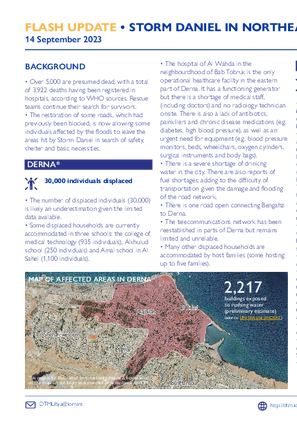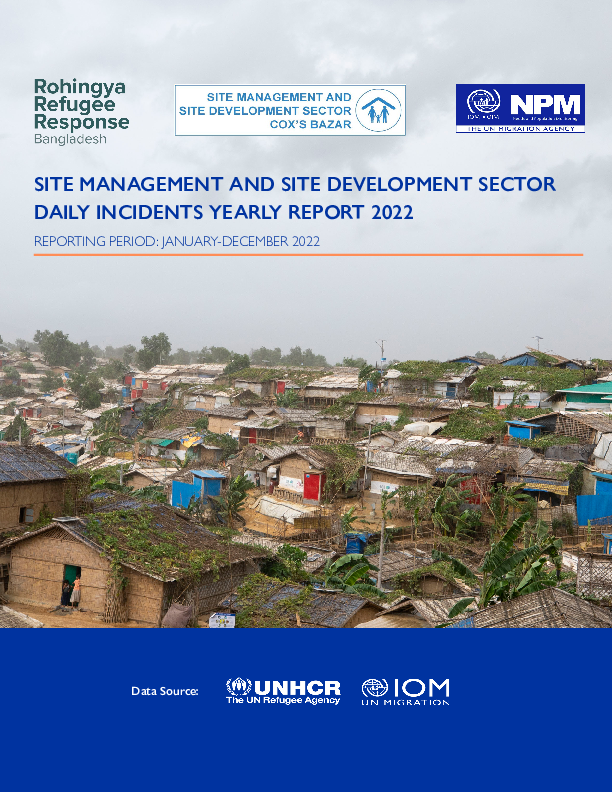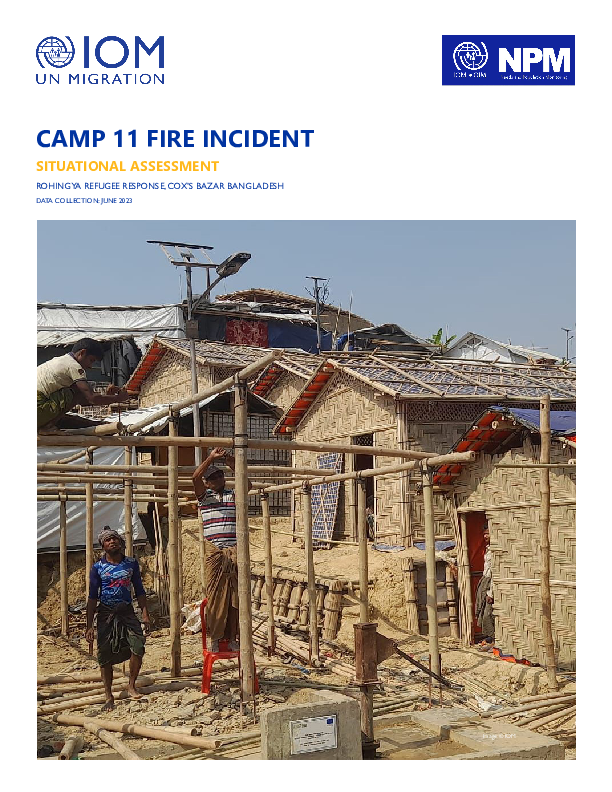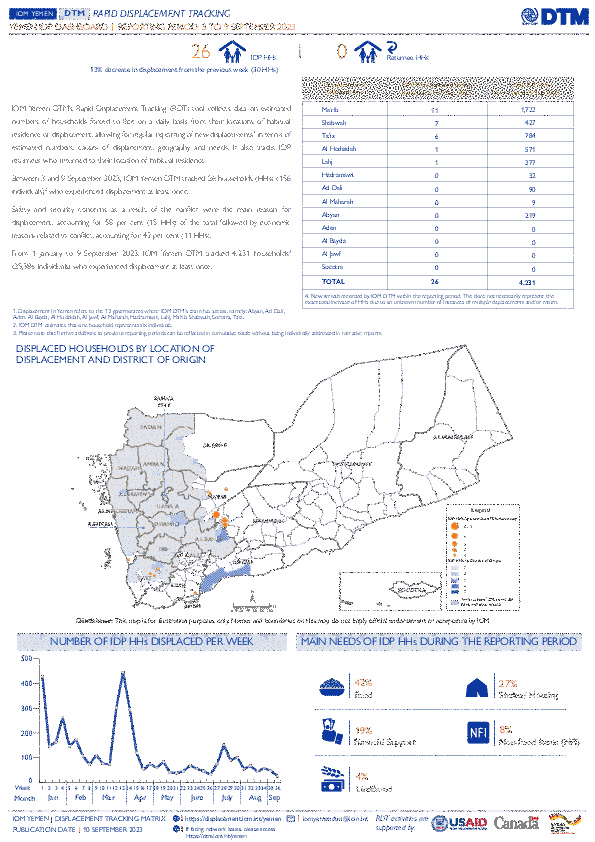-
Countries
-
Data and Analysis
-
Special Focus
-
Crisis Responses

Contact
DTMLibya@iom.int
Language
English
Location
Libya
Snapshot Date
Sep 14 2023
Activity
- Other
Over 5,000 are presumed dead, with a total of 3,922 deaths having been registered in hospitals, according to WHO sources. Rescue teams continue their search for survivors. • The restoration of some roads, which had previously been blocked, is now allowing some individuals affected by the floods to leave the areas hit by Storm Daniel in search of safety, shelter and basic necessities.
Contact
DTM Mozambique, DTMMozambique@iom.int
Location
Mozambique
Activity
- Mobility Tracking
- Site Assessment
Period Covered
Jul 12 2023 -Aug 04 2023
This summary presents findings of the 19th round of Mobility Tracking Assessments (previously known as Baseline Assessments) conducted across Northern and Central Mozambique through key-informant assessments and group interviews at location level between July and August 2023. Mobility Tracking assessments estimate the presence of internally displaced persons (IDPs) and returnees across Mozambique. IOM DTM mapped a total of 850,599 IDPs and 571,468 returnees in 325 locations. Overall increase on the number of IDPs and Returnees is attributable to the widened coverage. Comparing with previous assessments which covered only Northern Mozambique, the July-August 2023 assessment was widened to cover Manica, Sofala, Tete and Zambezia provinces.
Population Groups
Survey Methodology
Unit of Analysis Or Observation
Type of Survey or Assessment
Keywords
Geographical Scope
Administrative boundaries with available data
The current dataset covers the following administrative boundaries

Contact
NPM Bangladesh, npmbangladesh@iom.int
Language
English
Location
Bangladesh
Period Covered
Oct 01 2021
Sep 30 2022
Activity
- Survey
- Community Perception
After the Burmese military’s violent assault on Rohingya Muslims in Rakhine Province began in August 2017, when thousands of Rohingya people fled their homes with severe persecution resulting in the creation of the world’s largest refugee camps in Bangladesh. More than five years have passed yet; due to political complications, the repatriation process is still in a despair situation. A few of them (29,458) have been relocated to Bhasan Char, a small silt island in the Bay of Bengal; however, a high majority of the Rohingya refugee population is concentrated in overcrowded camps in Bangladesh’s Cox’s Bazar district’s Ukhiya and Teknaf Upazilas, where they endure dire conditions due to living in crammed shelters, poor quality sanitation, inadequate health assistance with other issues. Every year when the monsoon season approaches, living in the camps becomes more difficult. Currently, fires have become commonplace in the camps. To support the population, several humanitarian agencies are providing them with various services. Moreover, to effectively provide assistance, it is crucial to identify their met and unmet needs as well as the major service gaps. Hence, several MSNAs have previously been implemented to support the response.
Most recently, in 2021, the MSNA was conducted to inform the 2022 Joint Response Plan (JRP). But, in 2022 there was no MSNA has been conducted, which indicates key information gaps and a lack of in-depth sector needs assessment. A multisectoral needs assessment was required as each sector has its own needs assessments, which may not always be possible to analyse the data in a way that allows identifying priority needs and areas for development from a broad perspective, whereas a multi-sectoral assessment that is matched with the humanitarian program cycle and offers a strategic planning tool for evidence-based prioritizing.
In addition, the design and implementation of efficient inter-sectoral programming became more important as the crisis is gradually transitioning from the initial emergency phase to a more protracted response. Detailed information on the access difficulties, needs and priorities of all affected populations is required. However, currently, the funding for the Rohingya people has become more challenging since the focus has now shifted to the crisis in Ukraine, and Afghanistan. Hence, with limited resources, it is really difficult to understand what support is needed most, and how to prioritize the requirement. Therefore, the camp-based needs assessment (CBNA) has been planned and implemented throughout the camps under IOM’s area of responsibilities to provide an overview of the multi-sectoral needs and priorities of the refugees to support detailed humanitarian planning of IOM’s internal programs in meeting the strategic objectives of the donors.

Contact
NPM Bangladesh, npmbangladesh@iom.int
Language
English
Location
Bangladesh
Period Covered
Jan 01 2022
Dec 31 2022
Activity
- Other
Rohingya refugees live in the world’s largest refugee settlement in Bangladesh’s south-eastern district of Cox’s Bazar. The Myanmar military attack on Rakhine state in August 2017 forced thousands of Rohingya Muslims to escape to Bangladesh. Previous influxes were recorded in October 2016, when approximately 87,000 people crossed into Bangladesh, and other waves were registered during the previous decades. The total number of Rohingya refugees in Cox’s Bazar, including those residing in the district prior to August 2017 is estimated to be 960,5391 individuals. They live in difficult conditions, entirely depending on humanitarian aid. In the cramped conditions of camps besetting with other issues regarding accessing different services refugees’ torments rise during the cyclone and monsoon seasons every year because the population is concentrated in extremely congested sites within Ukhiya and Teknaf Upazilas of Cox’s Bazar district which is well-known to be vulnerable due to annual monsoon and cyclone seasons. Most of the shelters where the refugees live are made of tarpaulin sheets and bamboo in areas that are either hilly or low-lying.
The combination of densely populated sites and unsustainable shelter material exposes the refugee population to serious risks associated with heavy rains and high winds, such as flooding and landslides. To support the Rohingya refugee response during the cyclone and monsoon seasons the Site Management Site Development Sector (SMSD) Daily Incident Report (formerly known as the SM Category 1 Daily Incident Report) was established in May 2018. This system was developed by the SMSD Sector in coordination with the Inter Sector Coordination Group (ISCG), IOM, and UNHCR. Through this assessment, Site Management Support (SMS) Agencies systematically collect information across all camps in Cox’s Bazar affected by small and large-scale weather-related and man-made incidents. The incidents captured through this mechanism refer to small or large-scale localized events (such as landslides, floods, windstorms, heavy rain and fire) that cause minor to severe, even complete damage and have little to no impact outside of the locally affected area. In case of Level 2 or 3 events2 , of larger scope, the ISCG would trigger a JNA. The purpose of the system is to track any daily incidents across all camps, and their impact on the affected population.
Overall, the SMSD Incident Reporting is aimed at:
• Collect the initial information on the damages and displacement caused by small and large-scale weather-related and man-made incidents across all the camps on a daily basis. • Report the initial information for immediate action.
• Provide a comprehensive overview by producing reports and datasets on a Daily & Weekly basis to convey key information on the impact and damages caused by weather-related and man-made incidents across the camps.
• Support a timely and adequate Rohingya refugee response throughout the year, particularly during the cyclone and monsoon seasons.

Contact
NPM Bangladesh, npmbangladesh@iom.int
Language
English
Location
Bangladesh
Period Covered
Mar 01 2023
Jun 30 2023
Activity
- Survey
- Community Perception
The massive fire that swept through Camp 11 on March 5, 2023, affecting over 16,000 Rohingya refugees, severely damaged certain areas of the world’s largest refugee camps. Of these, 5,000 Rohingya refugees were temporarily displaced and moved to nearby camps. The fire destroyed 2,165 shelters and affected many refugees who were left with nothing. Three blocks (A, B, D) were affected with Block D having the most affected households (1,278).
IOM redirected efforts to assist those affected by the fire through rapid deployment of staff, resources, and uninterrupted presence in the camps. Moreover, IOM’s Needs and Population Monitoring team conducted Initial Rapid Needs Assessment within 24 hours to provide immediate response and In-depth Rapid Needs Assessments within 48 hours to support effective decision-making processes in meeting the needs of the affected population. In addition, in order to assess and to provide an overview of the current situation and humanitarian services and gaps, as well as to understand the driver and severity of needs of the affected population from each sector’s perspectives and to know the sufficiency and effectiveness of the assistance provided to the affected households, this household level situational assessment was conducted in June 2023 with the households affected by fire incident on March 5th. This report presents the overall findings of the assessment.

Contact
DTM Yemen, iomyemendtm@iom.int
Language
English
Location
Yemen
Period Covered
Sep 03 2023
Sep 09 2023
Activity
- Rapid Emergency Registration
- Mobility Tracking
IOM Yemen DTM’s Rapid Displacement Tracking (RDT) tool collects data on estimated numbers of households forced to flee on a daily basis from their locations of origin or displacement, allowing for regular reporting of new displacements in terms of estimated numbers, geography, and needs. It also tracks returnees who returned to their location of origin.
From 1 January to 9 September 2023, IOM Yemen DTM tracked 4,231 households (HH) (25,386 Individuals) who experienced displacement at least once.
Between 3 and 9 September 2023, IOM Yemen DTM tracked 26 households (156 individuals) displaced at least once. The majority of people moved into/within the following governorates and districts:
- Ma’rib (11 HHs) – Harib (7 HHs), Ma’rib City (3 HHs), Ma’rib (1 HH) districts. Most displacements in the governorate originated from Abyan and Al Hodeidah.
- Shabwah (7 HHs) – Bayhan (7 HHs) district. Most displacements in the governorate originated from Al Bayda and Dhamar.
- Ta’iz (6 HHs) – Al Qahirah (3 HHs), Al Mudhaffar (1 HH), Al Maafer (1 HH) districts.All displacements in the governorate were internal.
The majority of people moved from the following governorates and districts:
- Ta’iz (7 HHs) – At Ta’iziyah (2 HHs), Al Makha (1 HH), Salah (1 HH) districts.
- Al Hodeidah (5 HHs) – Al Qanawis (2 HHs), Zabid (1 HH), Al Marawiah (1 HH) districts.
- Al Bayda (5 HHs) – Maswarah (3 HHs), Nati (2 HHs) districts.
Contact
DTM Yemen, iomyemendtm@iom.int
Location
Yemen
Activity
- Mobility Tracking
Period Covered
Sep 03 2023 -Sep 09 2023
From 1 January to 9 September 2023, IOM Yemen DTM tracked 4,231 households (HH) (25,386 Individuals) who experienced displacement at least once.
Between 3 and 9 September 2023, IOM Yemen DTM tracked 26 households (156 individuals) displaced at least once. The majority of people moved into/within the following governorates and districts:
- Ma’rib (11 HHs) – Harib (7 HHs), Ma’rib City (3 HHs), Ma’rib (1 HH) districts. Most displacements in the governorate originated from Abyan and Al Hodeidah.
- Shabwah (7 HHs) – Bayhan (7 HHs) district. Most displacements in the governorate originated from Al Bayda and Dhamar.
- Ta’iz (6 HHs) – Al Qahirah (3 HHs), Al Mudhaffar (1 HH), Al Maafer (1 HH) districts.All displacements in the governorate were internal.
- Ta’iz (7 HHs) – At Ta’iziyah (2 HHs), Al Makha (1 HH), Salah (1 HH) districts.
- Al Hodeidah (5 HHs) – Al Qanawis (2 HHs), Zabid (1 HH), Al Marawiah (1 HH) districts.
- Al Bayda (5 HHs) – Maswarah (3 HHs), Nati (2 HHs) districts.
Population Groups
Survey Methodology
Unit of Analysis Or Observation
Type of Survey or Assessment
Keywords
Geographical Scope
Administrative boundaries with available data
The current dataset covers the following administrative boundaries
IDP and return locations (Adamawa State).
IDP and return locations (Yobe State).



